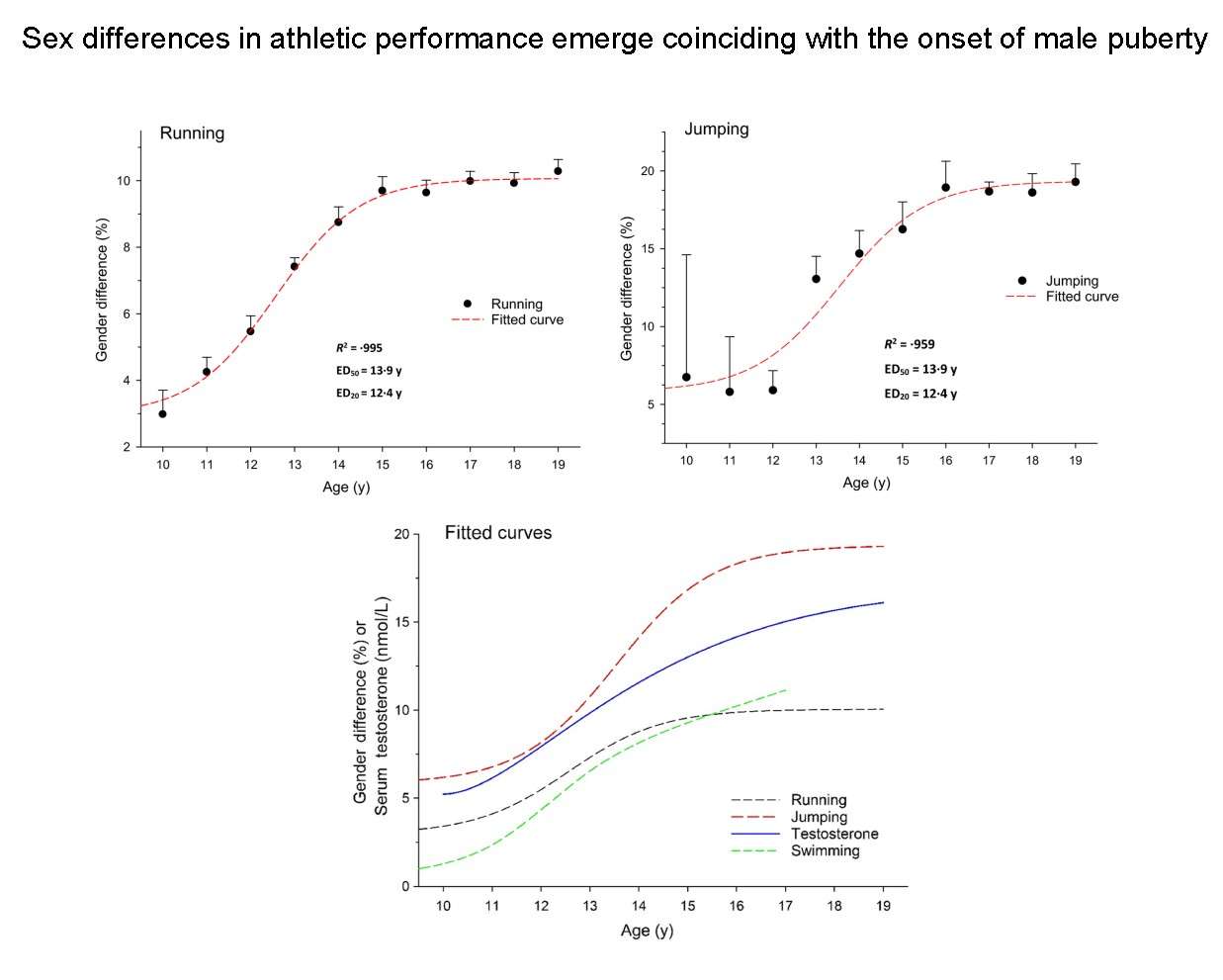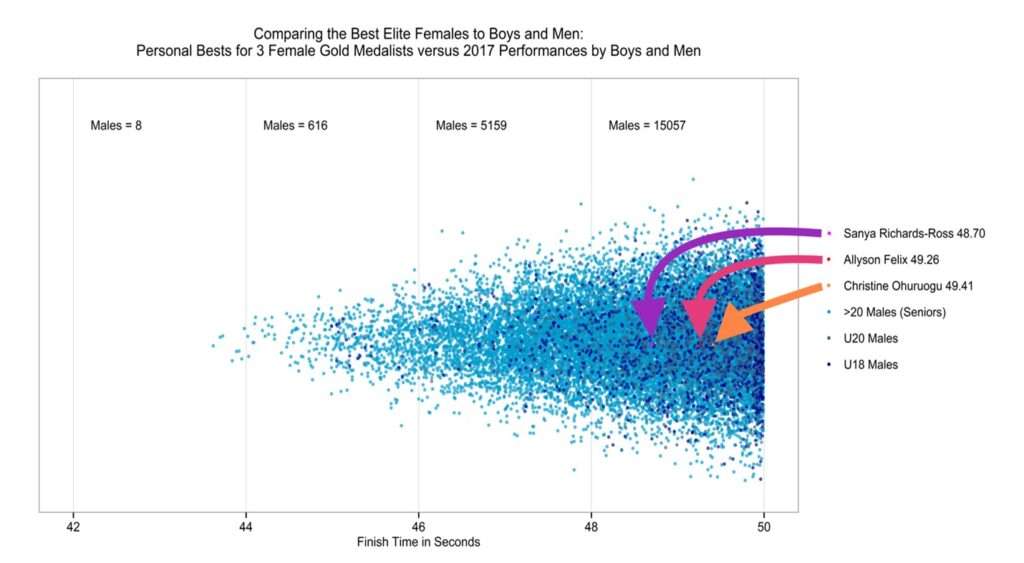After Caster Semenya, an intersex Rio Gold Medalist and athlete, was heard at Court of Arbitration for Sport (CAS), this series was written in March 2019 and published. It has now been proven that no medalist in the 800m women’s race in Rio was biologically female. Alternatively, the podiums for the men and women in this event were won by male athletes.
Also since I wrote last, the focus of the scientific work has been less on intersex athletes and more on transgender women and girls—specifically the extent to which it’s possible to mitigate male-sex linked performance advantages through testosterone suppression and/or gonadectomy. T is the hated hormone. Recently, there has been much hate from many people, such as activists at the ACLU and others who have spun the science and thoroughly politicized it. Many of these wrongs have been rectified by the relevant experts, such as Carole Hooven from Harvard, Emma Hilton and Ross Tucker. While we can argue over science facts and results data, it isn’t good policymaking to prevaricate about their nature.
[* * *]
A 2019 NYT editorial on anti-vaxxers states that “sometimes it is ok to get outside of the gray zone.” Science is not about black-and white statements. Scientists find it difficult to be comfortable with this. However, there are hard facts that should be revealed in the world of sex. From puberty, there is a noticeable performance gap between males as well as females. The primary reason for this difference is testosterone. The T ranges of male and female are very different. There’s no overlap. For some people, or all purposes, sex is not binary. Sport is different. What we really mean is “sex”. It is binary. “Full stop.”
The simplest way to put it is from The sport of Sex:
“The normal human fetus can either develop male organs or females depending on the genetic and hormonal influences.” In particular, “all developing embryos can become feminized without masculinizing influences.” [androgens]Key times during pregnancy are when they come in to play.” Sex differentiation, defined in the first instance as the development of the testes, is triggered by the SRY gene which is present on the Y chromosome…. Testicular production of testosterone is primarily responsible for the difference in male and female testosterone levels, both during development and throughout the individual’s lifetime…. [A]Although both men and women produce testosterone, there is more to male testosterone production than that of the adrenal glands, ovaries, cysts, or tumors.
Also from, the following number is also available: The sport of SexThis video demonstrates exactly what “a lot more” means:
T-Reference Ranges for Testosterone
Intersex – Sex typical and atypical

Sport converts the ng/dL units to nanomoles per Liter (nmol/l). These units show that the range of females is between 0.4 and 2.1 nmol/l, while the range for males is 10.2 to 39.9 (nmol/l); the difference is 8.1.
Males are 30 times more likely to have T than their female counterparts, even among elite athletes. Both transgender girls and women can be considered as such, starting at puberty. 46-XY males have the two most important differences in sex development (DSDs), 5ARD (alpha reductase deficiency), and PAIS(partial androgen sensitivity). The Gold, Silver, and Bronze medalists in the women’s 800 meters in Rio—Caster Semenya, Francine Nyonsaba, and Margaret Wambui—are all suspected of having the former condition. They’re not hyperandrogenic. These females are shown on the figure with 46-XX PCOS (polycystic orovars) and CAH [congenital adrenal hyperplasia].
Performance gaps are caused by differences in T levels. These three points are what the sport science community considers to be equivalent to judicially discernible facts.
First, the main physical attributes that contribute to elite athletic performance are power generation (speed and strength), which is based on muscle mass, muscle fiber type, and biomechanics; aerobic power (VO2 max), which is based on hemoglobin concentration, total blood volume, maximal stroke volume, cardiac size/mass/compliance, skeletal muscle blood flow, capillary density, and mitochondrial content; body composition, i.e., lean body mass and fat mass; and economy of motion, which is related to body composition.
Second, biological men and women are fundamentally different in their ability to use these attributes. Particularly, biological males are more lean than biological females (more skeletal muscles and less fat), have larger hearts, greater cardiac outputs and greater hemoglobin masses, greater VO2 max (also in absolute terms, scaled down to lean bodies mass), and have higher glycogen utilization and anaerobic ability.
A third factor that is responsible for the sex difference in elite athlete performance and gonadal men with functional androgen-receptors in their bodies, and in their growth and development (puberty) as well as throughout their athletic careers is testosterone. These differences are not caused by any other physiological or physical factors.
David Handlesman, an andrologist, shows how the performance gap develops and what the male puberty is like.

Wickliffe, Jeff Wald, Richard Clark and I created the next figure that brings these science facts alive. The individual is identified by the figure lifetime bests of three well-known female Olympic Champions in the 400 meters—Sanya Richards-Ross, Allyson Felix, and Christine Ohuruogu—in the sea of male-bodied performances run Only in 2017The data shows that by around 12%, the senior men would be able to beat the females. It also shows that Even when they are at their very bestThey’d lose thousands to boys and men who started at 0.1%.
The most significant tranches, however, are those ranging from 0.1% to 3.3%. In 2017, 6,959 male-bodied performers performed from 0.01%-3% of Ms. Richards Ross’s lifetime record. This contrasts to the combined 2,740 performances in tranches 3-11%. The performances of men between 0.01% and 3% are not considered to be elite, either at the college or international level.

Advocates for an identity-based eligibility rule argue—without any basis in the physical sciences, mind you—that the dominance of male-bodied athletes over female-bodied athletes is not necessarily due to their testosterone (‘T’) levels, i.e., that T is no more determinative of outcomes in sport than are other advantageous traits. Unless the point is the also-basic one that as between any two individuals—e.g., Allyson Felix and a random non-elite male who runs about the same times she does—T is not necessarily dispositive, this argument has no merit. In a NYT analysis article last year, I said, “Pick your geopolitical location and socioeconomic status, and then do comparative research.” Beginning in puberty, there will be both men and boys that can defeat the most talented girls.
To illustrate the point that anti-T people often use swimmers, I will end with this. The sport of Sex:
[T]The performance gap is still there even if we consider the fact that elite athletes can often be described as “freaks-of-nature” because of their unique physical attributes. The impact of sexuality, particularly testes, on athletes is more important than other biological differences.
Missy Franklin, a multiple Gold Medalist swimmer is 6′ 2″ tall and has a wingspan of 6 feet 4″. 2.04.06. This is her world record for the 200-meter backstroke. It was set in London at the 2012 Summer Olympics. Ryan Lochte set a world record of 1:53.94 at Beijing’s 2008 Olympics. It was nine seconds quicker than her own. Franklin, despite being the same height, would have been just a quarter of a lap behind Lochte at the finish, even though their wingspans are almost identical.
In a world in which competitors were categorized by height and wingspan—or just height or just wingspan—instead of sex, Franklin would not have had a world record; she would not have been on the podium; in fact, she would not have made the team. We might not know her name in such circumstances.

